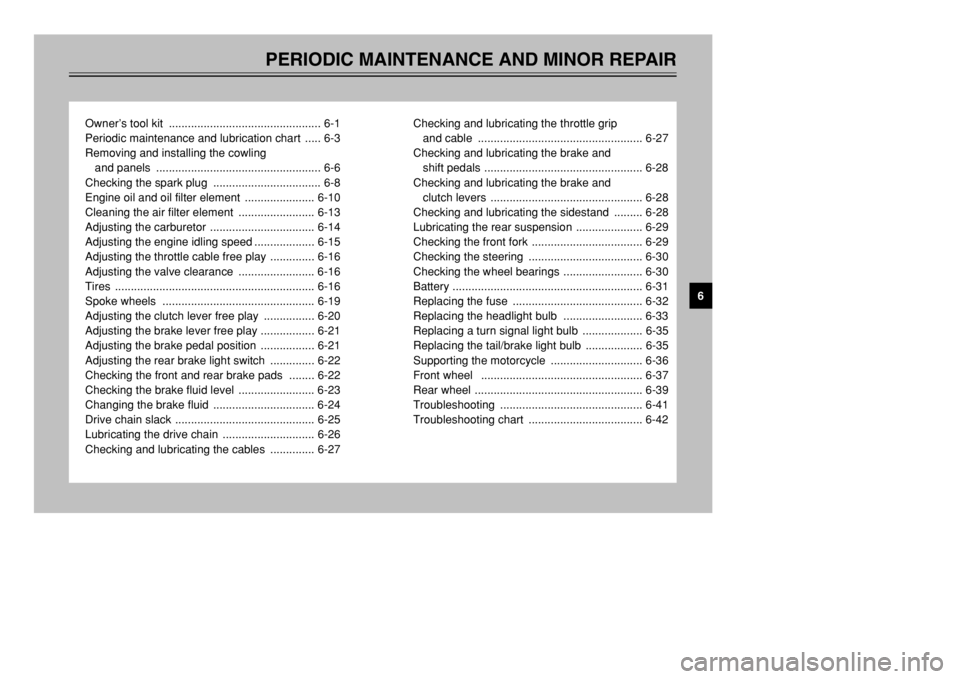clutch YAMAHA XT500E 2002 Owners Manual
[x] Cancel search | Manufacturer: YAMAHA, Model Year: 2002, Model line: XT500E, Model: YAMAHA XT500E 2002Pages: 100, PDF Size: 2.1 MB
Page 13 of 100

2-3
DESCRIPTION
2
1. Clutch lever (page 3-4, 6-20)
2. Left handlebar switches (page 3-3)
3. Speedometer unit (page 3-2)
4. Main switch/steering lock (page 3-1)
5. Tachometer (page 3-3)6. Right handlebar switches (page 3-4)
7. Brake lever (page 3-5, 6-21)
8. Throttle grip (page 6-16, 6-27)
9. Fuel tank cap (page 3-6)
1
234
5
67
8 9
Controls and instruments
4PT-E7 (English) 6/29/01 9:13 AM Page 12
Page 14 of 100

INSTRUMENT AND CONTROL FUNCTIONSMain switch/steering lock .................................................................. 3-1
Indicator lights .................................................................................. 3-2
Speedometer unit ............................................................................ 3-2
Tachometer ...................................................................................... 3-3
Handlebar switches .......................................................................... 3-3
Clutch lever ....................................................................................... 3-4
Shift pedal ......................................................................................... 3-5
Brake lever ....................................................................................... 3-5
Brake pedal ...................................................................................... 3-5
Fuel tank cap .................................................................................... 3-6
Fuel ................................................................................................... 3-6
Fuel cock .......................................................................................... 3-8
Starter (choke) knob ......................................................................... 3-9
Seat .................................................................................................. 3-9
Helmet holder ................................................................................. 3-10
Adjusting the shock absorber assembly ......................................... 3-10
Sidestand ........................................................................................ 3-11
Ignition circuit cut-off system .......................................................... 3-12
3
4PT-E7 (English) 6/29/01 9:13 AM Page 13
Page 18 of 100

3-4
INSTRUMENT AND CONTROL FUNCTIONS
3
EAU03890
Engine stop switch “$/#”Engine stop switchSet this switch to “#” before starting
the engine. Set this switch to “$” to
stop the engine in case of an emer-
gency, such as when the motorcycle
overturns or when the throttle cable is
stuck.
EAU00143
Start switch “,”Start switchPush this switch to crank the engine
with the starter.
EC000005
cCSee page 5-1 for starting instruc-
tions prior to starting the engine.
1
2
,
1. Engine stop switch “$/#”
2. Start switch “,”
EAU00152
Clutch leverClutch leverThe clutch lever is located at the left
handlebar grip. To disengage the
clutch, pull the lever toward the han-
dlebar grip. To engage the clutch,
release the lever. The lever should
be pulled rapidly and released slowly
for smooth clutch operation.
The clutch lever is equipped with a
clutch switch, which is part of the igni-
tion circuit cut-off system. (See page
3-12 for an explanation of the ignition
circuit cut-off system.)
1
1. Clutch lever
4PT-E7 (English) 6/29/01 9:13 AM Page 17
Page 19 of 100

3-5
EAU00157
Shift pedalShift pedalThe shift pedal is located on the left
side of the engine and is used in
combination with the clutch lever
when shifting the gears of the
5-speed constant-mesh transmission
equipped on this motorcycle.INSTRUMENT AND CONTROL FUNCTIONS
3
1
1. Shift pedal
EAU00158
Brake leverBrake leverThe brake lever is located at the right
handlebar grip. To apply the front
brake, pull the lever toward the han-
dlebar grip.
1
1. Brake lever
EAU00162
Brake pedalBrake pedalThe brake pedal is on the right side
of the motorcycle. To apply the rear
brake, press down on the brake
pedal.
1
1. Brake pedal
4PT-E7 (English) 6/29/01 9:13 AM Page 18
Page 26 of 100

3-12
INSTRUMENT AND CONTROL FUNCTIONS
3
EW000044
wThe motorcycle must not be ridden
with the sidestand down, or if the
sidestand cannot be properly
moved up (or does not stay up),
otherwise the sidestand could con-
tact the ground and distract the
operator, resulting in a possible
loss of control. Yamaha’s ignition
circuit cut-off system has been
designed to assist the operator in
fulfilling the responsibility of rais-
ing the sidestand before starting
off. Therefore, check this system
regularly as described below and
have a Yamaha dealer repair it if it
does not function properly.
EAU03720
Ignition circuit cut-off
systemIgnition circuit cut-off systemThe ignition circuit cut-off system
(comprising the sidestand switch,
clutch switch and neutral switch) has
the following functions.
8It prevents starting when the
transmission is in gear and the
sidestand is up, but the clutch
lever is not pulled.
8It prevents starting when the
transmission is in gear and the
clutch lever is pulled, but the
sidestand is still down.
8It cuts the running engine when
the transmission is in gear and
the sidestand is moved down.
Periodically check the operation of
the ignition circuit cut-off system
according to the following procedure.
EW000045
wIf a malfunction is noted, have a
Yamaha dealer check the system
before riding.
4PT-E7 (English) 6/29/01 9:13 AM Page 25
Page 27 of 100

3-13
INSTRUMENT AND CONTROL FUNCTIONS
3
With the engine turned off:
1. Move the sidestand down.
2. Make sure that the engine stop switch is set to “
#”.
3. Turn the key to “ON”.
4. Shift the transmission into the neutral position.
5. Push the start switch.
Does the engine start?
The neutral switch may be defective.
The motorcycle should not be ridden until
checked by a Yamaha dealer.
With the engine still running:
6. Move the sidestand up.
7. Keep the clutch lever pulled.
8. Shift the transmission into gear.
9. Move the sidestand down.
Does the engine stall?After the engine has stalled:
10. Move the sidestand up.
11. Keep the clutch lever pulled.
12. Push the start switch.
Does the engine start?
The sidestand switch may be defective.
The motorcycle should not be ridden until
checked by a Yamaha dealer.The clutch switch may be defective.
The motorcycle should not be ridden until
checked by a Yamaha dealer.
NO
NOTE:This check is most reliable if performed with
a warmed-up engine.
YESYES NO
The system is OK. The motorcycle can be ridden.
YES NO
4PT-E7 (English) 6/29/01 9:13 AM Page 26
Page 30 of 100

4-2
PRE-OPERATION CHECKS
4
Clutch•Check operation.
•Lubricate cable if necessary.
•Check lever free play.
•Adjust if necessary.3-4, 6-20
Throttle grip•Make sure that operation is smooth.
•Check free play.
•If necessary, have Yamaha dealer make adjustment or lubricate.6-16, 6-27
Control cables•Make sure that operation is smooth.
•Lubricate if necessary.6-27
Drive chain•Check chain slack.
•Adjust if necessary.
•Check chain condition.
•Lubricate if necessary.6-25–6-26
Wheels and tires•Check for damage.
•Check tire condition and tread depth.
•Check air pressure.
•Correct if necessary.6-16–6-19
Brake and shift pedals•Make sure that operation is smooth.
•Lubricate pedal pivoting points if necessary.6-28
Brake and clutch levers•Make sure that operation is smooth.
•Lubricate lever pivoting points if necessary.6-28
Sidestand•Make sure that operation is smooth.
•Lubricate pivot if necessary.6-28 ITEM CHECKS PAGE
4PT-E7 (English) 6/29/01 9:13 AM Page 29
Page 33 of 100

1. Turn the fuel cock lever to “ON”.
2. Turn the key to “ON” and make
sure that the engine stop switch
is set to “#”.
3. Shift the transmission into the
neutral position.NOTE:
When the transmission is in the neu-
tral position, the neutral indicator light
should be on, otherwise have a
Yamaha dealer check the electrical
circuit.4. Turn the starter (choke) on and
completely close the throttle.
(See page 3-9 for starter (choke)
operation.)
5. Start the engine by pushing the
start switch.
5-1
EAU00372
OPERATION AND IMPORTANT RIDING POINTS
5
EAU00373
w8Become thoroughly familiar
with all operating controls and
their functions before riding.
Consult a Yamaha dealer
regarding any control or func-
tion that you do not thorough-
ly understand.
8Never start the engine or oper-
ate it in a closed area for any
length of time. Exhaust fumes
are poisonous, and inhaling
them can cause loss of con-
sciousness and death within a
short time. Always make sure
that there is adequate ventila-
tion.
8Before starting out, make sure
that the sidestand is up. If the
sidestand is not raised com-
pletely, it could contact the
ground and distract the opera-
tor, resulting in a possible loss
of control.
EAU03515
Starting the engineStarting the engineIn order for the ignition circuit cut-off
system to enable starting, one of the
following conditions must be met:
8The transmission is in the neutral
position.
8The transmission is in gear with
the clutch lever pulled and the
sidestand up.
EW000054
w8Before starting the engine,
check the function of the igni-
tion circuit cut-off system
according to the procedure
described on page 3-13.
8Never ride with the sidestand
down.
4PT-E7 (English) 6/29/01 9:13 AM Page 32
Page 35 of 100

5-3
OPERATION AND IMPORTANT RIDING POINTS
5
EAU00423
ShiftingShiftingShifting gears lets you control the
amount of engine power available for
starting off, accelerating, climbing
hills, etc.
The gear positions are shown in the
illustration.NOTE:
To shift the transmission into the neu-
tral position, press the shift pedal
down repeatedly until it reaches the
end of its travel, and then slightly
raise it.
EC000048
cC8Even with the transmission in
the neutral position, do not
coast for long periods of time
with the engine off, and do not
tow the motorcycle for long
distances. The transmission is
properly lubricated only when
the engine is running.
Inadequate lubrication may
damage the transmission.
8Always use the clutch while
changing gears to avoid dam-
aging the engine, transmis-
sion, and drive train, which are
not designed to withstand the
shock of forced shifting.
EAU02941
Recommended shift points
(for Switzerland only)Shift points (for Switzerland only)The recommended shift points during
acceleration are shown in the table
below.NOTE:
When shifting down two gears at a
time, reduce the speed accordingly
(e.g., down to 35 km/h when shifting
from 4th to 2nd gear).
1
5
4
3
2
N
1
1. Shift pedal
N. Neutral position
Shift point (km/h)
1st →2nd 23
2nd →3rd 36
3rd →4th 50
4th →5th 60
4PT-E7 (English) 6/29/01 9:13 AM Page 34
Page 38 of 100

PERIODIC MAINTENANCE AND MINOR REPAIR
Owner’s tool kit ................................................ 6-1
Periodic maintenance and lubrication chart ..... 6-3
Removing and installing the cowling
and panels .................................................... 6-6
Checking the spark plug .................................. 6-8
Engine oil and oil filter element ...................... 6-10
Cleaning the air filter element ........................ 6-13
Adjusting the carburetor ................................. 6-14
Adjusting the engine idling speed ................... 6-15
Adjusting the throttle cable free play .............. 6-16
Adjusting the valve clearance ........................ 6-16
Tires ............................................................... 6-16
Spoke wheels ................................................ 6-19
Adjusting the clutch lever free play ................ 6-20
Adjusting the brake lever free play ................. 6-21
Adjusting the brake pedal position ................. 6-21
Adjusting the rear brake light switch .............. 6-22
Checking the front and rear brake pads ........ 6-22
Checking the brake fluid level ........................ 6-23
Changing the brake fluid ................................ 6-24
Drive chain slack ............................................ 6-25
Lubricating the drive chain ............................. 6-26
Checking and lubricating the cables .............. 6-27Checking and lubricating the throttle grip
and cable .................................................... 6-27
Checking and lubricating the brake and
shift pedals .................................................. 6-28
Checking and lubricating the brake and
clutch levers ................................................ 6-28
Checking and lubricating the sidestand ......... 6-28
Lubricating the rear suspension ..................... 6-29
Checking the front fork ................................... 6-29
Checking the steering .................................... 6-30
Checking the wheel bearings ......................... 6-30
Battery ............................................................ 6-31
Replacing the fuse ......................................... 6-32
Replacing the headlight bulb ......................... 6-33
Replacing a turn signal light bulb ................... 6-35
Replacing the tail/brake light bulb .................. 6-35
Supporting the motorcycle ............................. 6-36
Front wheel ................................................... 6-37
Rear wheel ..................................................... 6-39
Troubleshooting ............................................. 6-41
Troubleshooting chart .................................... 6-42
6
4PT-E7 (English) 6/29/01 9:13 AM Page 37